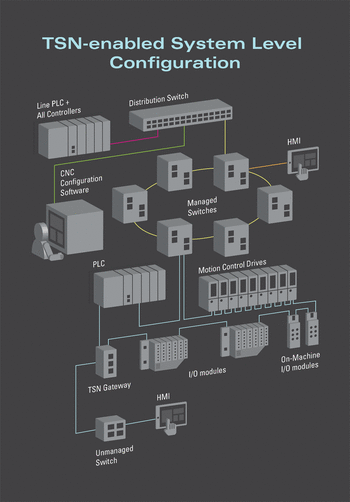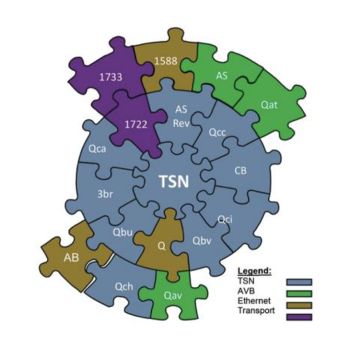Time-sensitive networking benefits for industrial systems
- December 17, 2019
- Best Practices
- Automation
Time-sensitive networking (TSN) can simplify industrial systems and reduce system and hardware costs, an appealing choice for companies looking to harness data in the Industrie 4.0 and Industrial Internet of Things (IIoT) era.

The user is provided a view of the system that allows for the configuration of the I/O and control devices as well as for the layout of the topology and the infrastructure devices. Courtesy: Avnu Alliance
The emergence of the Internet of Things (IoT) is driving the need for networked, time-aware systems in all sectors of the economy. Evolution of the Industrial Internet of Things (IIoT) will increase the amount of data harvested through distributed networks, requiring new methods for managing and transferring critical and non-critical information.
Demand for higher levels of reliability and security are increasing and engineers are looking for alternatives to today’s specialized and segregated industrial communication standards. The latest set of IEEE 802.1 time-sensitive networking (TSN) standards represents the next evolution of standard Ethernet technologies, targeted to meet these new market demands.
Industrial control applications require consistent and deterministic delivery of data from sensors to controllers and to actuators. The data exchanged between these components is critical in controlling any manufacturing process and it is imperative that interference or hindrance of this exchange is minimized. This has not been problematic for most automation systems, as control data has been physically segmented from information data over separate networks.
However, the IIoT proposition changes that paradigm because manufacturers seek insights and analytical information from the same sensors and devices also controlling the process. The total amount of data communicated over the same network increases. Some data is critical for control systems while other data is needed for information and analytical systems.
TSN is one way to ensure this control data traffic is delivered by securing bandwidth in the network infrastructure, while simultaneously allowing non-critical forms of data traffic to coexist on the same network. TSN provides tools to enable the convergence of different data traffic on the same physical network, reducing the infrastructure cost.
What is TSN (Time-Sensitive Networking)?
TSN is a collection of Ethernet standards introduced by IEEE that defines a new set of mechanisms for managing traffic. TSN standards define new functions for Ethernet networking such as traffic shaping, frame pre-emption, traffic scheduling, ingress policing, and seamless redundancy. When all parts of a network run with the same sense of time, traffic can be coordinated based on a schedule, one method that allows for better control of critical traffic.
These features provide a new layer of control for managing Ethernet traffic. However, from a business perspective, is TSN worth the investment? If TSN represents yet another layer of new standards added to an already complex system, how can TSN create a simpler system for the end user?

TSN standards allow network communications to be managed for guaranteed performance and data delivery.
Determine TSN value for a company
TSN standards were designed to facilitate system-level configuration and were created with a system view in mind, rather than from a component perspective. TSN enables end-stations to publish requirements on the network and allows bridges and switches in the system to announce their capabilities to the wider network.
For example, the “P802.1Qcc – Stream Reservation Protocol (SRP) Enhancements and Performance Improvements” specification is one of the mechanisms designed to allow the network infrastructure to be more intelligent at a system level and to convey the information necessary to transition the control plane from a manual configuration workflow to an automated process.
In this future architecture, the user is provided a view of the system that allows for the configuration of the input/output (I/O) and control devices as well as for the layout of the topology and the infrastructure devices. A core principle of the TSN value proposition is all network communications are managed so performance and data delivery are guaranteed. To accomplish this, all devices need to participate in traffic planning by publishing to or notifying the system of its traffic requirements and its capabilities for managing traffic. In this example, a centralized network configuration engine is used to configure the system. In a distributed model, several domain managers operate the system.
In this future reality, the centralized network configuration is an intelligent tool enabled by the information collected and conveyed from TSN standards. It will calculate the best possible solution to accommodate all the traffic flows between all connections in the network. The system sees the available bandwidth and configures the infrastructure components in the network (the bridges) to accommodate the traffic flows. If the system cannot solve for a configuration that meets the performance requirements and loads of the traffic streams in the subnet, it will notify the user so topology, performance requirements or loading can be modified.

The user is provided a view of the system that allows for the configuration of the I/O and control devices as well as for the layout of the topology and the infrastructure devices. Courtesy: Avnu Alliance
TSN makes it possible to run the calculations that can help the implementor predict if a network design will be successful for a given application. TSN enables the convergence of networks and systems that were kept separate for reasons such as operational integrity, real-time performance, safety or security. Breaking down communication barriers between critical and non-critical systems is a foundational concept of the IIoT and Industrie 4.0. With TSN and time synchronization, insights from real-time data at the edge arrives on time from anywhere, no matter how demanding the environment. Choosing TSN can change the industrial model for a more converged and deterministic network built on platforms to protect long-term investments.
TSN and its accompanying smart software offer the ability for a smart system to configure the network infrastructure.
With TSN’s network intelligence, it becomes more automated and less dependent on human intervention and subsequent error.
Industrial TSN benefits
Digital technology powered by TSN infrastructure may enable shorter operational lead times, more visibility over systems and more efficient asset utilization. These benefits can pave the way for additional improvements by future-proofing today’s systems including:
- Ease of network configuration: Today, technicians have to configure each network device manually on conventional networks. TSN can allow for automatic configuration via intelligent configuration tools. The network understands what must happen to achieve the desired performance and will turn specific services on and off as necessary. Standardized methods for network-wide configuration and commissioning required by TSN also create the avenue for offline simulation as well as network and architecture modeling.
- Secure networks: Security is critical for industrial automation and control networks. Because TSN is standard Ethernet, control networks can take advantage of security best practices developed into Ethernet for decades. TSN also adds a layer of security to the data with the precise timing mechanism that facilitates early detection of a network breach.
- Reduced system costs: TSN allows the convergence of di?erent traffic classes on one network, which reduces overall system costs. Hardware and maintenance costs may also be reduced since the system needs fewer devices and cables.
- Future network enhancements: TSN is part of the Ethernet family, which means the technology will not limit bandwidth and other performance criteria. New nodes can be added to the network and discovered via standard networking protocols.
For these reasons, TSN is the platform on which tomorrow’s networks will be built. Choosing TSN can change the industrial model for a more converged and deterministic network built on platforms to protect investments long-term.
Benefits of an ecosystem approach
Many of today’s underlying systems for Industrie 4.0 applications are based on proprietary standards and could present integration challenges. A lack of a broader industrial ecosystem perspective for business systems, platforms and standards as well as interoperability could present a significant challenge for the adoption of Industrie 4.0 into modern workflows.
Consortia, industry and government bodies as well as standards associations are working to adopt standards, associated profiles and tests. It is incumbent upon everyone involved in the ecosystem to work with partners to stay current on evolving standards, make them interoperable and coexist to maximize the value delivered by Industrie 4.0.
Industry groups are collaborating to create a set of unified standards and an interoperable ecosystem for the industrial market. Due to the broad set of use cases that are addressed by IIoT, the market continues to require multiple upper-layer protocols for networked industrial systems. These upper-level protocols share a common TSN foundation.
Author
Anil Kumar, principal engineer, Intel; Denzil Roberts, Ph.D., systems architect, Intel; Steve Zuponcic, technology manager, Rockwell Automation; Avnu Alliance industrial segment members. Edited by Chris Vavra, production editor, Control Engineering, CFE Media, [email protected].
MORE ANSWERS
Keywords: Ethernet, time-sensitive networking, Industrial Internet of Things (IIoT)
Time-sensitive networking (TSN) is a collection of Ethernet standards that can help companies better manage the increasing data flows coming in.
TSN benefits for businesses include easier network configurations, lower system costs and better security standards.
Groups are working to adopt standards associated with Industrie 4.0 so companies can adopt them into modern workflows.
More about Avnu Alliance: This organization facilitates a common TSN platform through various services, including open-source software, and test plans to develop and verify the correct operation and implementation of TSN-enabled products. Avnu ensures there is one set of test plans for conformance based on the market-defined requirements for TSN. Test plans can be used by test houses, protocol organizations and test equipment manufacturers to ensure the industrial market is testing to the same TSN specifications and guarantee an interoperable network layer for proper system interoperability. Avnu works with other industry consortia and standards organizations, such as IEEE and Industrial Internet Consortium, as well as organizations that provide conformance testing for application layers.